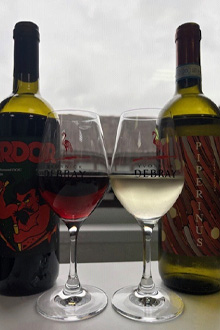Wine52 Case Review: Volcanic Italy

Whilst we prefer to imagine Italy as a beautiful, bucolic country of rolling hills, vineyards, beaches and sun, the dramatic landscape is shaped by volcanic formations that form an integral part of the cultural divides between the provinces and, of course, of the eco-system and soils for wine!
The scope for this case is vast covering regions from Lazio and Campania along the western shores to Basilicata in the South and Veneto towards the Alps.
Volcanic soils and wine are a bit of a match made in heaven, and Italy is blessed by its geographical past in this regard. Mineral rich, extremely fertile, free-draining and complex patchworks, volcanic soils provide all the right ingredients for excellent wines. Whether it’s the mineral backbone that the wines tend to possess, the wonderfully high acidity to bring balance to the wine, or the earthy, flinty characteristics, volcanic wines are among some of the best.
The Wine Tasting
Piperinus Frascati DOC
Hailing from the Roman hills of Frascati, Piperinus is a perfect blend of Malvasia Puntinata and Trebbiano. Malvasia Puntinata, or Malvasia del Lazio, is commonly used for dessert wines and is the noblest white grape variety in Frascati. It is relatively aromatic, fruity and floral with a mineral character driven by the soils. Trebbiano Toscano (Ugni Blanc in France) is an important balancer bringing acidity and freshness to the wine. There’s also a touch of Bombino and Malvasia Bianca di Candia for good measure.
So, quite a blend! But how is it? Expressive was the first word that came to mind. Exuding lemon skin, quince, acacia, peach, apricot, blossom and honey, it keeps the fruit in balance with good acidity and mineral undertones that you’d expect of the soils. It is light and elegant but with surprisingly strong fruit concentration - a great evening sipper.
Despite the name meaning “of pepper” in Latin, (even though they have got the declension ending wrong! – knew that Classics degree would come in handy), the wine is not particularly peppery (if at all). That said, I don’t think it is trying to be, but I can certainly see it going with a nice pasta and some fresh black pepper!
Trilussa Castelli Romani Bianco DOC
Castelli Romani covers the wider area of the Alban Hills, within which sits Frascati, and was/is Rome’s wine version of a bread basket. The Trilussa’s vineyards are exposed to cooler aspects, with breezes coming in from the Apennines and Tyrrhenian Sea, helping encourage bright fruit flavours and freshness.

This is a blend of Malvasia Puntinata, Trebbiano and Greco which brings a real point of difference compared to the Piperinus that is exciting to explore. Ripe green apple, pear and ripe lemon carry through from the Malvasia and Trebbiano, and the Greco brings body, floral, stone fruit and smoky elements to the wine. It’s got great structure and poise.
Ardor Castelli Romani Rosso DOC
Ardor is a more familiar Italian blend, taking Montepulciano and Sangiovese together and forging a great wine, as the label and name might suggest.
Red and black fruit driven, with cassis, wild berries and strong red cherry notes, this wine belies its complexity at first. Delve a little deeper and uncover earthy, savoury depth with structure and stony mineral character. A lovely bright fruity finish is supported by acidity and the volcanic mineral streak.
Overall, it’s full-bodied and wonderfully smooth.
Erupting in style, the latest Wine52 case an exciting exploration honing in on Italy’s unique soils and giving some great contrasting wines to compare.
- Clever exploration providinga full on experience tasting the volcanic styles
- Wines with varietal and terroir character
- A very informative glug magazine and Italian snacks
- Latin!
Grab your free case now! >